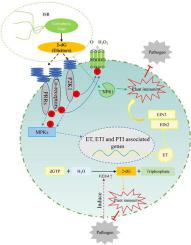Journal of Advanced Research ( IF 11.4 ) Pub Date : 2022-07-08 , DOI: 10.1016/j.jare.2022.06.014 Chongchong Lu 1 , Qingbin Wang 2 , Yanke Jiang 1 , Min Zhang 3 , Xuanlin Meng 1 , Yang Li 1 , Baoyou Liu 1 , Ziyi Yin 1 , Haifeng Liu 1 , Chune Peng 1 , Fuchuan Li 4 , Yingzhe Yue 1 , Mingxia Hao 1 , Yurong Sui 1 , Lulu Wang 1 , Guodong Cheng 5 , Jianzhu Liu 5 , Zhaohui Chu 6 , Changxiang Zhu 1 , Hansong Dong 1 , Xinhua Ding 1

|
Introduction
Beneficial microorganisms play essential roles in plant growth and induced systemic resistance (ISR) by releasing signaling molecules. Our previous study obtained the crude extract from beneficial endophyte Paecilomyces variotii, termed ZNC (ZhiNengCong), which significantly enhanced plant resistance to pathogen even at 100 ng/ml. However, the immunoreactive components of ZNC remain unclear. Here, we further identified one of the immunoreactive components of ZNC is a nucleoside 2′-deoxyguanosine (2-dG).
Objectives
This paper intends to reveal the molecular mechanism of microbial-derived 2′-deoxyguanosine (2-dG) in activating plant immunity, and the role of plant-derived 2-dG in plant immunity.
Methods
The components of ZNC were separated using a high-performance liquid chromatography (HPLC), and 2-dG is identified using a HPLC–mass spectrometry system (LC-MS). Transcriptome analysis and genetic experiments were used to reveal the immune signaling pathway dependent on 2-dG activation of plant immunity.
Results
This study identified 2′-deoxyguanosine (2-dG) as one of the immunoreactive components from ZNC. And 2-dG significantly enhanced plant pathogen resistance even at 10 ng/ml (37.42 nM). Furthermore, 2-dG-induced resistance depends on NPR1, pattern-recognition receptors/coreceptors, ATP receptor P2K1 (DORN1), ethylene signaling but not salicylic acid accumulation. In addition, we identified Arabidopsis VENOSA4 (VEN4) was involved in 2-dG biosynthesis and could convert dGTP to 2-dG, and vne4 mutant plants were more susceptible to pathogens.
Conclusion
In summary, microbial-derived 2-dG may act as a novel immune signaling molecule involved in plant-microorganism interactions, and VEN4 is 2-dG biosynthesis gene and plays a key role in plant immunity.
中文翻译:

在微生物和植物中发现一种新型核苷免疫信号分子 2'-脱氧鸟苷
介绍
有益微生物通过释放信号分子在植物生长和诱导系统抗性 (ISR) 中发挥重要作用。我们之前的研究获得了有益内生菌拟青霉的粗提物,称为 ZNC (ZhiNengCong),即使在 100 ng/ml 时也能显着增强植物对病原体的抗性。然而,ZNC 的免疫反应成分仍不清楚。在这里,我们进一步确定了 ZNC 的一种免疫反应成分是核苷 2'-脱氧鸟苷 (2-dG)。
目标
本文旨在揭示微生物来源的2'-脱氧鸟苷(2-dG)激活植物免疫的分子机制,以及植物来源的2-dG在植物免疫中的作用。
方法
使用高效液相色谱 (HPLC) 分离 ZNC 的成分,并使用 HPLC-质谱系统 (LC-MS) 鉴定 2-dG。转录组分析和遗传实验被用来揭示依赖于植物免疫的 2-dG 激活的免疫信号通路。
结果
该研究将 2'-脱氧鸟苷 (2-dG) 鉴定为 ZNC 的免疫反应成分之一。并且 2-dG 即使在 10 ng/ml (37.42 nM) 时也能显着增强植物病原体抗性。此外,2-dG 诱导的耐药性取决于 NPR1、模式识别受体/辅助受体、ATP 受体 P2K1 (DORN1)、乙烯信号而非水杨酸积累。此外,我们发现拟南芥VENOSA4 (VEN4) 参与了 2-dG 的生物合成,并且可以将 dGTP 转化为 2-dG,并且vne4突变植物对病原体更敏感。
结论
综上所述,微生物来源的 2-dG 可能作为参与植物-微生物相互作用的新型免疫信号分子,而VEN4是 2-dG 生物合成基因,在植物免疫中起着关键作用。











































 京公网安备 11010802027423号
京公网安备 11010802027423号